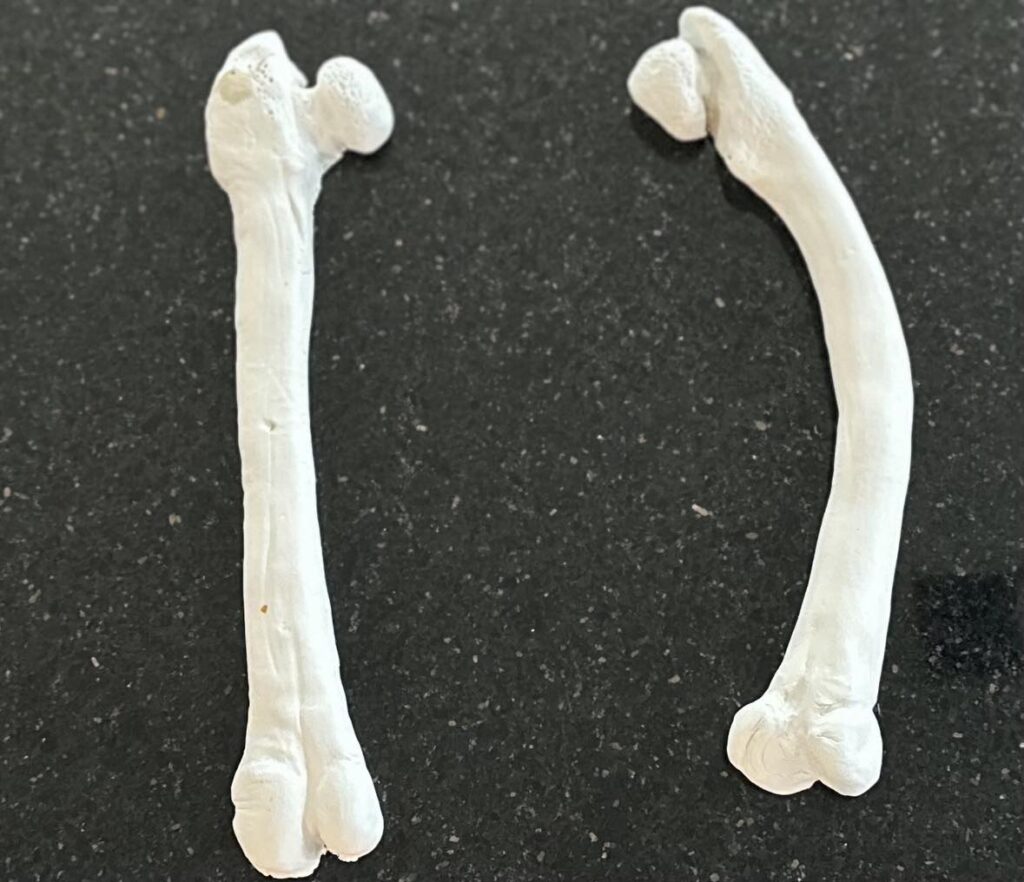For my STEAM project, I wanted to elaborate on topic of development and remodeling of bones in our body. One subject that really stuck out to me was the topic of osteoporosis, which was a topic we studied more in depth. While studying osteoporosis, our textbook compared the disease to Paget’s disease, yet never explained these comparisons or the disease itself. I have taken it upon myself to research this disease in more depth as well as model a set of femurs, long bones, affected by Paget’s disease using modeling clay.
Paget’s disease is a nonmalignant disorder of the skeleton, characterized by abnormalities in the process of bone remodeling, pain, deformities, and fractures of the bone. (Ralston, et al.) Like osteoporosis, any bone can be affected by this disease, but the pelvis, spine, femur, tibia, and skull are more likely to contract it. Osteoporosis affects more women than men, but Paget’s disease affects more men than women as well as men over 50 years of age. (Mayo Clinic) In Paget’s disease, patients have abnormal activation of osteoclasts which in turn increases the rate of bone remodeling. Osteoblastic activity then increases to match this rate of remodeling with bone development. (Banaganapalli, et al.) This increase of productivity induces a disorganization in the cycle of bone development and repair. (Ralston, et al.) The bones and areas affected by Paget’s are typically localized in the activity which causes vascularized benign growths. The new bone produced is often weaker than normal bone due to this disorganization. (Banaganapalli. et al.) It has been scientifically recognized that Paget’s disease has relation to familial genetics are environmental precursors. Studies have shown that there is a correlation between genetics and environmental factors that may lead to a patient obtaining the disease. (Banaganapalli, et al.)
Paget’s disease can affect a single bone (monostotic), or two bones (polystotic). (Maatallah, et al.) The affected bones can then deform the stability of the skeleton. I have modeled a pair of femurs, one affected by Paget’s. With the increase in bone formation on one side of the body, the bone thickens, but due to the disorganization of development and remodeling, the new bone is weaker and begins to bow. (Banaganapalli, et al.) This symptom is indicative to the disease and can greatly affect the hips and equilibrium of the skeletal structure. This disruption in balance causes a variety of issues such as osteoarthritis and nerve pinching when the spine is affected. (Mayo Clinic) This disease is completely treatable when diagnosed and addressed.


Sam clearly evaluated the objective of bone development and remodeling. I remember reading a short clinical study in our textbook regarding Paget’s disease, but no elaboration on the disease. What I found most interesting is that this is more common in men than women, opposite of osteoporosis. You made it clear how Paget’s disease occurs involving disorganization in the production of osteoclasts and osteoblasts. Your model also makes it very clear on how Paget’s can be localized in the bone, causing one side to remodel different than the other in the same bone. You mentioned how it can lead to deformities in the skeleton and osteoarthritis. If Paget’s occurred in the femur I can only imagine how much of a domino effect this would have on the skeletal structure! Some things I am curious about is how do most people get diagnosed? Does it cause pain and they go in to get it checked? Or do they typically fall have a fracture, and this leads to imagining which then in return gets diagnosed? What sort of treatments help this disease? I remember that with osteoporosis it can be as simple as hormone medication, along with diet and exercise. I did some quick research and it looks like step one is medication, primarily bisphosphonates. Apparently one dose can have long term effects for the patient. Step two involves surgery if it cannot be corrected. I found your research to be factual, clear, and concise on the objective. Great job on the clay modeling as well, it looks professional and detailed as you even made it have spongy bone appearance!